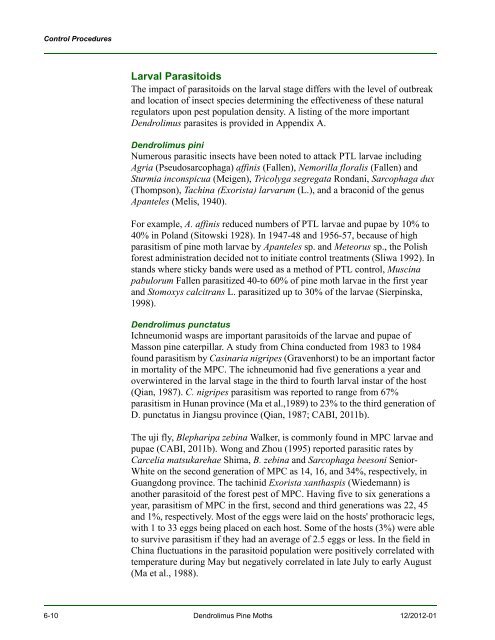New Pest Response Guidelines - aphis - US Department of Agriculture
New Pest Response Guidelines - aphis - US Department of Agriculture
New Pest Response Guidelines - aphis - US Department of Agriculture
You also want an ePaper? Increase the reach of your titles
YUMPU automatically turns print PDFs into web optimized ePapers that Google loves.
Control Procedures<br />
Larval Parasitoids<br />
The impact <strong>of</strong> parasitoids on the larval stage differs with the level <strong>of</strong> outbreak<br />
and location <strong>of</strong> insect species determining the effectiveness <strong>of</strong> these natural<br />
regulators upon pest population density. A listing <strong>of</strong> the more important<br />
Dendrolimus parasites is provided in Appendix A.<br />
Dendrolimus pini<br />
Numerous parasitic insects have been noted to attack PTL larvae including<br />
Agria (Pseudosarcophaga) affinis (Fallen), Nemorilla floralis (Fallen) and<br />
Sturmia inconspicua (Meigen), Tricolyga segregata Rondani, Sarcophaga dux<br />
(Thompson), Tachina (Exorista) larvarum (L.), and a braconid <strong>of</strong> the genus<br />
Apanteles (Melis, 1940).<br />
For example, A. affinis reduced numbers <strong>of</strong> PTL larvae and pupae by 10% to<br />
40% in Poland (Sitowski 1928). In 1947-48 and 1956-57, because <strong>of</strong> high<br />
parasitism <strong>of</strong> pine moth larvae by Apanteles sp. and Meteorus sp., the Polish<br />
forest administration decided not to initiate control treatments (Sliwa 1992). In<br />
stands where sticky bands were used as a method <strong>of</strong> PTL control, Muscina<br />
pabulorum Fallen parasitized 40-to 60% <strong>of</strong> pine moth larvae in the first year<br />
and Stomoxys calcitrans L. parasitized up to 30% <strong>of</strong> the larvae (Sierpinska,<br />
1998).<br />
Dendrolimus punctatus<br />
Ichneumonid wasps are important parasitoids <strong>of</strong> the larvae and pupae <strong>of</strong><br />
Masson pine caterpillar. A study from China conducted from 1983 to 1984<br />
found parasitism by Casinaria nigripes (Gravenhorst) to be an important factor<br />
in mortality <strong>of</strong> the MPC. The ichneumonid had five generations a year and<br />
overwintered in the larval stage in the third to fourth larval instar <strong>of</strong> the host<br />
(Qian, 1987). C. nigripes parasitism was reported to range from 67%<br />
parasitism in Hunan province (Ma et al.,1989) to 23% to the third generation <strong>of</strong><br />
D. punctatus in Jiangsu province (Qian, 1987; CABI, 2011b).<br />
The uji fly, Blepharipa zebina Walker, is commonly found in MPC larvae and<br />
pupae (CABI, 2011b). Wong and Zhou (1995) reported parasitic rates by<br />
Carcelia matsukarehae Shima, B. zebina and Sarcophaga beesoni Senior-<br />
White on the second generation <strong>of</strong> MPC as 14, 16, and 34%, respectively, in<br />
Guangdong province. The tachinid Exorista xanthaspis (Wiedemann) is<br />
another parasitoid <strong>of</strong> the forest pest <strong>of</strong> MPC. Having five to six generations a<br />
year, parasitism <strong>of</strong> MPC in the first, second and third generations was 22, 45<br />
and 1%, respectively. Most <strong>of</strong> the eggs were laid on the hosts' prothoracic legs,<br />
with 1 to 33 eggs being placed on each host. Some <strong>of</strong> the hosts (3%) were able<br />
to survive parasitism if they had an average <strong>of</strong> 2.5 eggs or less. In the field in<br />
China fluctuations in the parasitoid population were positively correlated with<br />
temperature during May but negatively correlated in late July to early August<br />
(Ma et al., 1988).<br />
6-10 Dendrolimus Pine Moths 12/2012-01

















